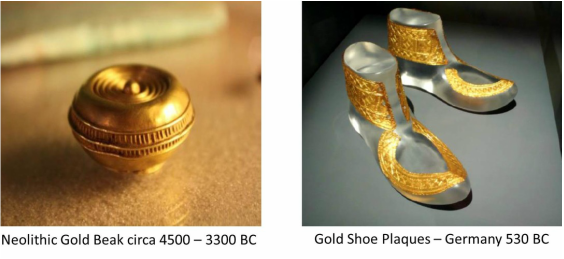NEXT MEETING
September 22, 2016
THOMAS L. ALTSHULER, FASM
Ancient Metallurgy 4600 BC to 1648 CE - The Jewels, Tools and Weapons of Our Ancestors
September 22, 2016
THOMAS L. ALTSHULER, FASM
Ancient Metallurgy 4600 BC to 1648 CE - The Jewels, Tools and Weapons of Our Ancestors

Even though Georgius Agricola, with the publication of his 16th century book “De re Metallica”, is considered the father of metallurgy, our ancestors were forming the first gold objects during the late Paleolithic Period some 42,000 years ago. People in the Neolithic Period from 10,200 BC to 4500 BC discovered metals lying on the ground and began fashioning them into jewelry and weapons. Hence the beginning of the age of metals as civilization moved away from the Stone Age. About 3500 BC, it was discovered that by combining copper and tin, a superior metal could be made, the alloy bronze, representing a major technological shift known as the Bronze Age. Egyptian weapons made from meteoric iron in about 3000 BC were highly prized as "daggers from heaven”.
Many developments were made thereafter to obtain useful metals from mining ores, refining these ores and extracting metals from these ores. Further developments were made in terms of mixing molten metals together to form alloys with enhanced properties and fashioning metals into desired products. Ancient metallurgy was developed independently by different civilizations namely the Chinese, the Incas, the peoples of the Middle East, the Egyptians, the Greeks and the Romans. The process of metallurgy found by archaeologists in these regions will be shown with photos of many interesting and beautiful products made from 4600 BC to about 1648 AD.
Several examples are shown below. Please join us for an entertaining evening where Dr. Altshuler will guide us through the history of our ancestors and their metallurgical skills.
Thomas L. Altshuler is currently an engineering consultant. He was the president and owner of the Advanced Materials Laboratory, Inc. His specialties include physical and mechanical metallurgy emphasizing creative problem solving. He is experienced in engineering, basic research, and teaching. His contributions have been in the fields of Scanning Probe Microscopy (nanotechnology), mechanical and physical testing of composites and other materials from room temperature to 2 degrees Kelvin, superconductivity, dislocations, infrared engineering, inventing medical devices (IR 100 award), and development of a computer program for fatigue design. He was a Visiting Full Professor at Northeastern University, Associate Professor at Dartmouth College, and Assistant Professor at Fitchburg State College. He also was a Consulting Engineer at Digital Equipment Corp., a Senior Scientist at the NASA Electronics Research Center, an engineer at GCA, General Electric Co., and Radio Corp. of America, and served aboard a Destroyer Escort as a LTJG in the U.S. Navy. He has five patents, five additional patent disclosures, and twenty-nine publications.
He received a Doctor of Philosophy from Oxford University followed by postdoctoral training at the University of Pennsylvania, MS from Columbia University, and BS from the University of California at Berkeley. He is a licensed Professional Engineer in New York (by exam), New Hampshire, and Massachusetts. He has been elected as a Fellow ASM International (2002).
